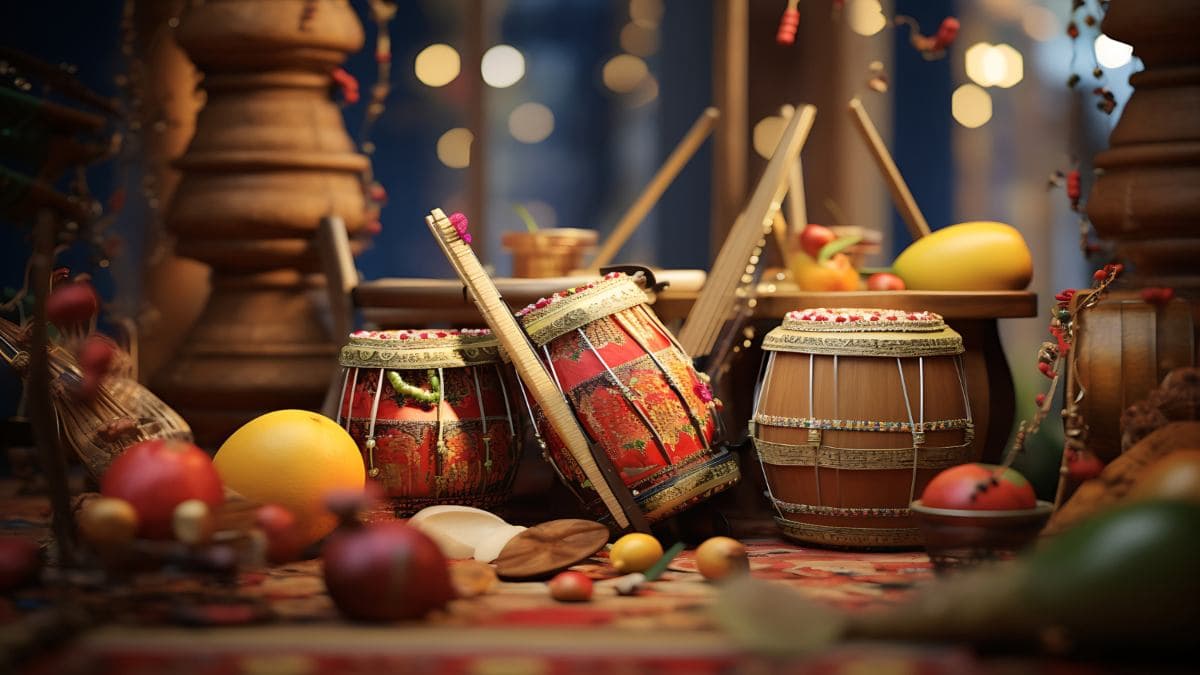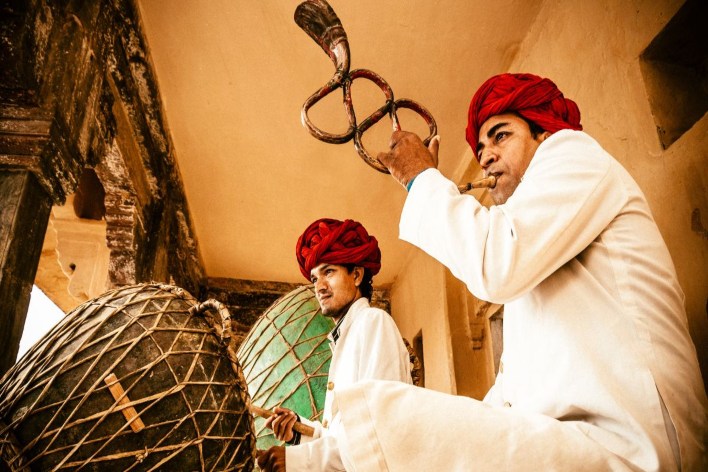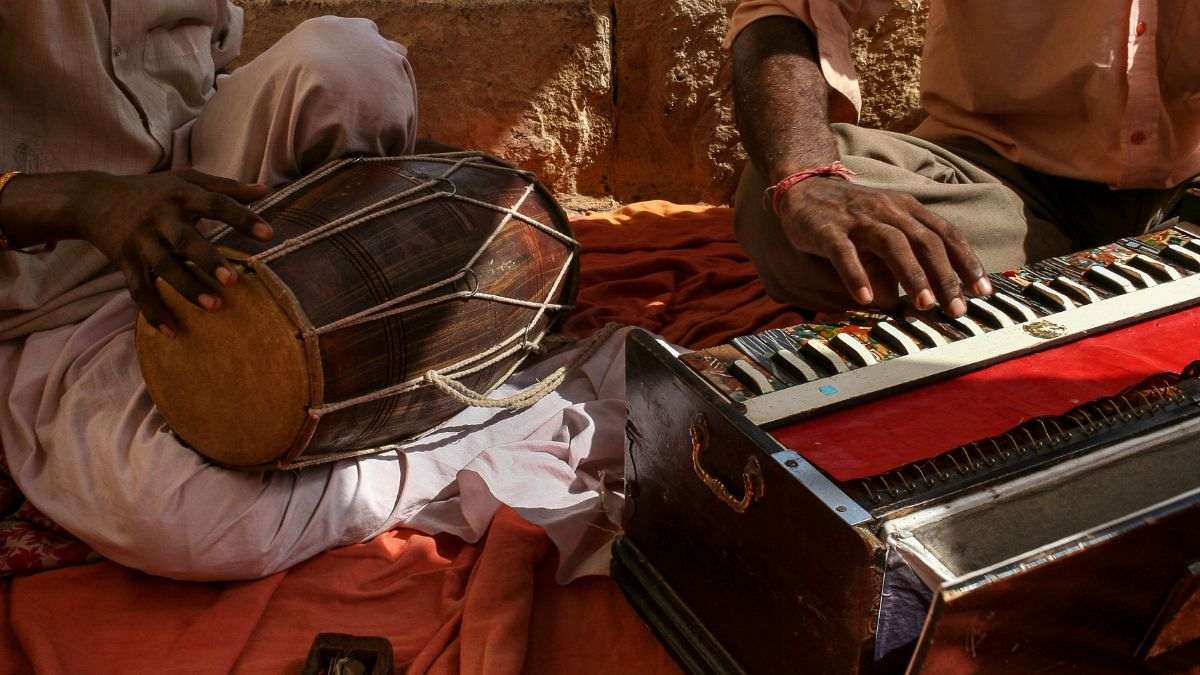What Are Folk Songs And Their Types In India?
By Pinkey Sharma |
Date 22-08-2024

Table of Contents
Admissions Open for
Folk songs constitute a strong tradition of the rich cultural heritage of India. Folk songs reflect the different traditions and customs of different communities inhabiting this land. Indian folk songs are not just a mode of entertainment but a source through which age-old occurrences and traditions are carried from one generation to another. So, through this paper, we will examine appropriately what folk songs are, their significance, and the varieties of folk songs found in India.
What Is a Folk Song?
A folk song is a traditional composition that originated among the people of a certain region or community. Most of the songs were passed on orally from one generation to the next and became part of the cultural identity of a community. Folk songs tell stories, recount important events, convey moral lessons, and portray people's day-to-day life and feelings.
Folk songs have their place in the very diversified cultural spirit of India. Many Indian folk songs are still quite primitive. Because Indian folk songs are so rich in nature, they add real belief to this fact that tradition is linked integrally to the land where it originates.

Types of Folk Songs in India
These are a mirror of India's cultural diversity. Some of the prominent types of Indian folk songs, each specific to their characteristics and regional significance, are as follows:
1. Bihu Songs (Assam)
Bihu songs are related to the Bihu festival, which signifies the Assamese New Year. It is meant to be performed with the traditional Bihu dance and is in a very lively and energetic rhythm, expressing the merriment of agriculture and the onset of spring.
2. Lavani (Maharashtra)
Lavani is an ancient folk song and dance form of Maharashtra with strict rhythm and fast beat. It deals with themes of love, social, and political and is enacted by the women folk performers in colorful costumes.
3. Baul Songs (West Bengal)
Baul songs are part of the spiritual folk songs sung by Bauls. They are a community of mystic minstrels belonging to Bengal. These songs involve a quest in the inside of the self.
4. Garba Songs (Gujarat)
The garba songs have deep, philosophical lyrics, but with simple and soulful tunes.
The Garba songs are associated with the extremely popular folk dance called Garba, which is performed during Navratri in Gujarat. Most of these songs are devotional in nature and invoke Goddess Durga. They are sung with rhythmic clapping and circular dance movements.
5. Bhatiali (West Bengal)
Bhatiali songs are traditional boat songs, sung by the boatmen of Bengal, in a plaintive melodious way, which represent the life of fishermen and the beauty of rivers in Bengal.
6. Pandavani (Chhattisgarh)
The folk songs are sung to narrate the stories about the Pandavas and other episodes from the Mahabharata. A single individual presents the complete show with dramatic facial expressions; simple musical instruments are used to enhance the dramatic quality and to enliven the narrative in a way that it communicates excitement and tension in each episode.
7. Rajasthani Lok Geet (Rajasthan)
Rajasthani folk songs are a rich cultural heritage of the state. They have covered ranges from Maand, Panihari to Pabuji Ki Phad; have tough stories on gallantry, romance, and simple life of Rajasthan.
8. Haryanvi Ragini (Haryana)
Haryanvi Ragini is a traditional folk song of Haryana, which is full of robust and rhythmic characteristics. Such songs depict local legends, the topics of social issues, and folk tales, which are then enacted when it comes to village gatherings and fairs.
9. Nattupura Paatu (Tamil Nadu)
Naatupura Paatu is the rural folk music from Tamil Nadu. The songs praise agricultural life, local deities, and folklore and are sung to the beats of traditional instruments such as the Thavil and Nadaswaram.
10. Gondhal (Maharashtra)
It is a ritualistic form of folk music, mostly in Maharashtra, associated with religious ceremonies and festivals. Songs are essentially dedicated to different deities and are performed along with traditional dance forms and musical instruments.
The Importance of Indian Folk Songs
Indian folk songs are essential parts of cultural, social, and educational components; thus, their importance is of a very high order with cultural, social, and educational values. Given below are the most important reasons for which they are important:
1. Preservation of Heritage
It is through the folk songs that most of India's rich cultural heritage finds a living storehouse. They help preserve what the winds of time may scatter, which includes many aspects such as ancient traditions, languages, and stories. Folk songs begin to educate youngsters about history and cultural roots.
2. Community Bonding
They are sung mainly during community meetings, festivals, and jubilations, and, as such, create togetherness. They bring people together, social bonds, and cultural identity.
3. Expression of Emotions
Folk songs are a medium of expression for a gamut of human feelings, ranging from rejoicing and celebration to sorrow and longing. They are the songs of human activity tinctured with the throbbing of daily life—hence, very appealing in a way.
4. Education and Morality
Many of the folk songs are didactic and would carry along the moral lessons and wisdom. They would teach values such as honesty and boldness, respect for nature, and others. They work as an educational tool.
5. Cultural Diversity
The wide range of India's folk songs attests to the multi-cultural character of the nation. The various musical traditions associated with the diverse regions of the nation identify the plurality and richness of the culture.
6. Entertaining factors
Folk songs form an entertaining factor in themselves. They entertain and bring joy to the people of all ages. It is very often accompanied by dance and dramatics, thus making the presentation lively and entertaining in nature.
Revival and Preservation of Folk-Songs
Lately, there has been much interest in the revival and preservation of folk-songs of India. Cultural organizations, musicians, and government initiatives across India are working to preserve these traditional art forms. Here are some of the ways through which folk songs are being preserved.
1. Documentation of Folk Music:
The various organizations and individuals can be involved in documentation and archiving of the folk songs. This is through recording of performances both in audio and video, lyrics transcription, and preservation of traditional musical instruments.
2. Festivals and Competitions:
The music festivals and competitions will be an opportunity provided for the folk artists to showcase their talent. This brings diversity in Indian folk Music together and it also helps the young budding artists to learn and sing such traditional songs.
3. Educational Programs:
Folk music is included in school curricula and in music education courses. This way, young children get accustomed to such folk art. Workshops and other forms of training conducted by folk musicians also help a lot in educating people on the existence and preservation of such folk songs.
4. Collaborations and Fusion:
Many folk artists are currently being paired with contemporary musicians who merge traditional folk music with modern-day music. In doing so, the covering and rejuvenation of folk songs make them quite relevant for today's music world.
5. Media and Technology:
The use of media and technology has gone a long way in popularizing folk songs. In fact, television programs and online platforms have specifically created an area for folk music. This way, folk songs get to reach different audiences across the world.
Evolution of Folk Music from Ancient India
Folk music in India goes way back and, like the rest of the developed world, has undergone several changes. This section shall view the evolution of Indian folk music in respect of how it has changed yet retained its core essence.
Ancient Beginnings
The roots of Indian folk music can be traced to the Vedic period, dating from 1500-500 BCE. In that period, the essence of music was chiefly used for religious rituals and ceremonies. The Vedas— ancient Hindu scriptures—contain hymns and chants that were sung in a specific melodic structure called Samagana. These musical forms developed the base of both classical and folk music traditions that would succeed in India.
Regional Cultures and Their Influence
With diversification into its different regions, developing with different languages, traditions, and customs, regional folk music styles began to emerge. They were much influenced by the native culture, lifestyle, and activities, giving a variety of folk songs that reflect the identities of individuals.
For example, the Bhakti movement swept medieval India. It carried forward from the 6th to the 17th century and had a great influence on the folk music of India. In fact, the devotional movement developed a heightened sense of personal devotion to the deities and inspired a plethora of devotional songs across different regions. Consequently, it appealed to the commoners for its emphasis on the accessible use of language and emotional expression. This appeal leaves many folk songs from this movement surviving even to this day.
Integration of Folk and Classical Music
The relationship that developed between folk and classical music during the period of the Middle Ages was one of reciprocity. Several classical musicians were recorded to have used folk song, rhythm, and instruments to enrich their own work. Folk music was successfully composed by adapting instruments or styles of the Classical Period. In this way, both genres cross-pollinated in a number of ways and a heightened amount of diversity resulted as well.
For example, there are so many classical ragas, executed using classical ragas, while using folk tunes. Further, various folk elements have been applied in the classical dance forms like Kathak and Bharatanatyam, reflecting the smooth co-existence of the two musical traditions.

Revival and Preservation Efforts
The realignment of the preservation and revival of folk music in India is going through a renaissance in the present era. The governmental bodies, cultural organizations, and individual artists have taken a number of initiatives to document and propagate the folk tradition. A genuine attempt is being made to see that the majestic heritage of Indian folk music is not lost in the onslaught of globalization and cultural homogenization.
1. Governmental: Various levels of governmental organizations have initiated programs in documenting and conserving the traditions of folk music. Sangeet Natak Akademi and other cultural institutions, through grants, scholarships, sponsorships, and performance opportunities, extend their support to the folk artists.
2. Cultural Festivals: Folk music festivals, such as Jodhpur RIFF (Rajasthan International Folk Festival) and Sur Jahan in Kolkata, signify the dimension of Indian folk music. It is through these festivals that folk musicians have been given an opportunity to express their talent globally through various audiences.
3. Education Programs: As part of the school curriculum and music education programs, the practice of introducing folk music aids in familiarizing young children with the classic arts. Workshops and other types of training programs by the folk musicians are also important tools for imparting and conserving traditional in nature songs.
4. Media and Technology: Digitization of media and technology has made it easier to record, archive, and circulate folk music. Online platforms, such as YouTube and social media, have made the world closer to the doorsteps of a folk artist by offering an international audience. Recording studios and music labels make it easier to compile and circulate folk music albums.
Folk songs for Kids
Indian folk songs are like musical stories from different parts of India. They tell tales of festivals, heroes, and everyday life. Each region has its own special songs and dances, making them colorful and exciting. Listening to these songs is a fun way to learn about India's rich culture!
Conclusion
Folk songs are a very important part of India's heritage; they help in understanding the lives, tales, and traditions of a variety of people. Knowing what folk songs are and seeing the varieties of Indian folk songs helps us appreciate the diversity and richness of the art form. Folk songs, thus preserved and promoted, ensure that this invaluable cultural legacy blooms to inspire the future. Embracing the beauty and significance of Indian folk songs connects us with our roots and celebrates the timeless tradition of storytelling through music.
This journey of Indian folk music from time immemorial to modern times is a pointer to its resilience and adaptability. Through so many ups and downs coming under influences, the basic characteristics of folk music remained the same as the protector of the blood flow of people's life, their emotions, and cultural identity. By understanding and appreciating these different types of Indian folk songs and their historical significance, we help preserve this rich cultural heritage for future generations. Not only does folk music connect us with the past, but it also enriches the present by celebrating the diversity and unity that is India.
FAQs
1.Why is it called a folk song?
The term 'Folk' is a blanket term referring to all sorts of musical, oral, and cultural traditions from specific regions and societies around the world. Folk comes from the German word 'Volk', meaning 'the people', and folk music is often thought of as being the music belonging to 'the people'.
2. What are folk songs and their meaning?
A song originating among the people of a country or area, passed by oral tradition from one singer or generation to the next, often existing in several versions, and marked generally by simple, modal melody and stanzaic, narrative verse.
3. What is considered Folk Music?
The contemporary folk music genre is defined as a primarily English genre utilizing traditional, acoustic instruments
If you liked the blog, then don’t forget to share it with your friends and family, spread the joy of Indian folk songs in your community!
Other Related Blogs
Punjabi Folk Songs: A Collection of Culture and Tradition
Goan Folk Songs: The Vibrant World
Other Related Sections
NCERT Solutions | Sample Papers | CBSE SYLLABUS| Calculators | Converters | Stories For Kids | Poems for kids | Practice Worksheets | Formulas I Parent Resources
CBSE Schools In Popular Cities
- CBSE Schools in Bangalore
- CBSE Schools in Mumbai
- CBSE Schools in Pune
- CBSE Schools in Hyderabad
- CBSE Schools in Chennai
- CBSE Schools in Gurgaon
- CBSE Schools in Kolkata
- CBSE Schools in Indore
- CBSE Schools in Sonipat
- CBSE Schools in Delhi
- CBSE Schools in Rohtak
- CBSE Schools in Bhopal
- CBSE Schools in Aurangabad
- CBSE Schools in Jabalpur
- CBSE Schools in Jaipur
- CBSE Schools in Jodhpur
- CBSE Schools in Nagpur
- CBSE Schools in Ahmednagar
- CBSE School In Tumkur

Call Us to know more about Orchids
Swipe Up

















